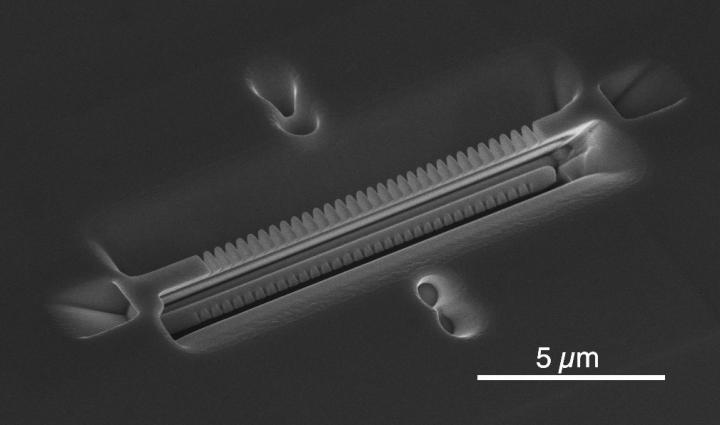Mar 31 2020
At Caltech, a team of engineers has demonstrated that atoms in optical cavities, or small boxes for light, could be the basis for developing a quantum internet. The study was reported in the Nature journal on March 30th, 2020.
 A nanophotonic cavity created by the Faraon lab. Image Credit: Faraon lab/Caltech.
A nanophotonic cavity created by the Faraon lab. Image Credit: Faraon lab/Caltech.
Quantum networks would link quantum computers via a system that also functions at a quantum level, and not a classical level. It has been proposed that in the future, quantum computers will be able to carry out specific functions faster than classical computers by leveraging the unique properties of quantum mechanics, such as superposition, which enables quantum bits to store information as 1 and 0 at the same time.
Similar to connecting multiple classical computers, engineers would intend to connect several quantum computers for data sharing and working together, thereby forming a “quantum internet.” This would pave the way for various applications, such as solving computations that are highly enormous to be performed by a single quantum computer and developing everlasting, secure communications with quantum cryptography.
If a quantum network must work, it should be in a position to transmit information between two points without modifying the quantum properties of the information that is transmitted. One existing model works in this way: a single ion or atom serves as a quantum bit (or “qubit”) that stores information through one of its quantum properties, for example, spin.
That information is read and transmitted elsewhere by exciting the atom using a pulse of light, which makes it emit a photon, the spin of which is entangled with the atom’s spin. Then, the photon can transmit the information encoded with the atom over a long distance through fiber optic cable.
It is challenging to find atoms that can be controlled and measured, and that also not so sensitive to fluctuations in electric or magnetic fields that cause errors, or decoherence.
Solid-state emitters that interact well with light often fall victim to decoherence; that is, they stop storing information in a way that’s useful from the prospective of quantum engineering.
Jon Kindem (MS ’17, PhD ’19), Study Lead Author, Caltech
At the same time, atoms of rare-earth elements—with properties that render the elements useful as qubits—exhibit poor interaction with light.
Led by Andrei Faraon (BS ’04) Caltech professor of applied physics and electrical engineering, the researchers overcame this difficulty by creating a nanophotonic cavity—a beam measuring nearly 10 μm in length with periodic nano-patterning, made from a piece of crystal.
Then, a rare-earth ytterbium ion was identified by the researchers at the center of the beam. The optical cavity enables the light to bounce backward and forward down the beam several times before the ion finally absorbs it.
In the paper, the researchers demonstrated that the ion’s environment is altered by the cavity such that a photon emitted by the ion remains in the cavity over 99% of the time, which can then be efficiently collected and detected to measure the state of the ion. This leads to an increase in the rate at which photons are emitted by the ion, thus enhancing the overall effectiveness of the system.
Moreover, the ytterbium ions have the ability to store information in their spin for 30 ms. Within this span, the information could be transmitted by light to travel across the continental United States.
This checks most of the boxes. It’s a rare-earth ion that absorbs and emits photons in exactly the way we’d need to create a quantum network. This could form the backbone technology for the quantum internet.
Andrei Faraon, Professor of Applied Physics and Electrical Engineering, Caltech
At present, the focus of the researchers is to develop the foundational blocks of a quantum network. As a next step, they intend to scale up the experiments and connect two quantum bits, stated Faraon.
Co-authors of the paper titled “Control and single-shot readout of an ion embedded in a nanophotonic cavity” are graduate students Andrei Ruskuc and Jake Rochman (MS ’19), former postdoctoral researcher John Bartholomew, and Yan Qi Huan (BS ’19).
This study was financially supported by the National Science Foundation, the Air Force Office of Scientific Research, and the Institute for Quantum Information and Matter (IQIM) at Caltech. The Kavli Nanoscience Institute Laboratory (KNI) at Caltech was used for this study.